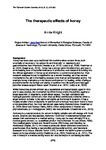The therapeutic effects of honey
| dc.contributor.author | Knight, A. | |
| dc.date.accessioned | 2019-05-15T16:03:23Z | |
| dc.date.available | 2019-05-15T16:03:23Z | |
| dc.date.issued | 2013 | |
| dc.identifier.citation |
Knight, A. (2013) 'The therapeutic effects of honey', The Plymouth Student Scientist, 6(1), p. 375-385. | en_US |
| dc.identifier.issn | 1754-2383 | |
| dc.identifier.uri | http://hdl.handle.net/10026.1/14023 | |
| dc.description | Honey has been used as a traditional folk medicine since ancient times, both externally on wounds to the epidermis and internally for respiratory and gastrointestinal tract infections (Mandal et al., 2010; Lusby et al., 2005; Kwakman et al., 2010; Ayaad et al., 2010). Honey has a proven anti-microbial effect, and due to an increasing level of bacterial resistance to antibiotics, new research is looking into the clinical application of honey as an alternative to conventional antibiotics. Most research analyses honey for application as a wound dressing, as it has several mechanisms that aid in the healing process other than an anti-bacterial activity. For example honey maintains a moist wound environment for healing, whilst offering a protective barrier via its high osmolarity; in addition the mild acidity and hydrogen peroxide release support tissue repair (Mandal et al., 2010; Lusby et al., 2005). Whilst honey has proven efficient as a bactericidal and bacteriostatic agent in vitro and in case studies, the mechanism by which honey exerts this activity, against a broad spectrum of organisms, is still under debate. The high osmolarity and hydrogen peroxide content are often cited as likely contributors; however, when a sugar solution is made to the same osmolarity as the honey in question, it has a notably smaller effect on bacteria. In addition some honeys have been found to have a non-peroxide affect, the most well-known case being Manuka honey (Kwakman et al., 2010; Snow and Manley-Harris, 2004). Other components of interest are phytochemicals, pH, methyglyoxal (MGO) and bee defensin-1(Kwakman et al., 2010). As honey is a natural product, its content is highly variable and will change with floral source, location and bee species, therefore it is difficult to standardise honeys and assess their usefulness in a medical setting. Honey can be used clinically if it is a medical grade product, i.e. a sterilised product that is licensed for use (Molan, 2006). Two medical grade honeys are Revamil source (RS) honey, and Manuka, i.e. Medihoney (Majtan, 2011); RS honey is produced under controlled conditions in greenhouses (thus having a reproducible anti-bacterial activity), and Manuka is assessed for a Unique Manuka Factor (UMF), in which the batch is given a number based on its bactericidal activity (Kwakman et al., 2010; Kwakman et al., 2011). The use of honey in a medical setting would not only be helpful in combating bacterial The Plymouth Student Scientist, 2013, 6, (1), 376-385 [377] resistance (there is no evidence to suggest bacteria develop resistance to honey), but aid the treatment of infections in developing countries, as honey is cheap, easily available and may avert the need for other more expensive medical treatments. Moghazy et al. (2010) also suggested after their in vivo experiment in Egypt that due to its long standing use as a remedy in certain countries, it may have a psychological benefit over other treatments. | en_US |
| dc.language.iso | en | en_US |
| dc.publisher | University of Plymouth | |
| dc.rights | Attribution 3.0 United States | * |
| dc.rights.uri | http://creativecommons.org/licenses/by/3.0/us/ | * |
| dc.subject | honey | en_US |
| dc.subject | traditional folk medicine | en_US |
| dc.subject | anti-microbial effect | en_US |
| dc.subject | therapeutic effects | en_US |
| dc.subject | bees | en_US |
| dc.title | The therapeutic effects of honey | en_US |
| dc.type | Article | |
| plymouth.issue | 1 | |
| plymouth.volume | 6 | |
| plymouth.journal | The Plymouth Student Scientist |



